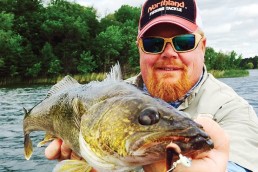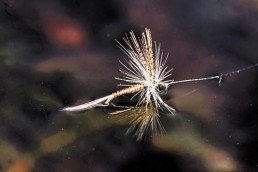Fly-in Lakes Call for Finesse Tactics
SHARE THIS POST
More decades ago than I care to remember, I took my first flight into a remote lake for a week of fishing in the great Northwoods. I had a wonderful time, caught and ate some fish, told jokes, enjoyed the secluded surroundings and learned some lessons I’ve never forgotten. One of the most valuable was tactics to use when the fishing gets tough.
When my angling friends and I head north, we try to choose our gear with the objective of putting the odds in our favor. There’s no doubt that the catching can get pretty lean and we have to resort to every finesse tactic we know. This is especially true when targeting one of the most finicky fish, the ever-popular walleye.
Over the years we’ve broken down our selection of gear into three categories, with the first being rods and reels. Since our primary goal in going to a Canadian lake is to catch walleyes with a few northerns, we’ll try to match our equipment to the species. Given the limited amount of space on a charter plane though, we’ve found that three rods per angler is the right number. Two-piece rods will fit into a telescoping rod case and won’t take up space on a plane. At least one should be a 7-foot, medium-action spinning rod matched with a quality reel and loaded with 8-pound-test fluorocarbon and or braided line. Fluorocarbon is just about invisible, and in the clearer waters of the Northwoods this can be a real bonus. Braided line, which has no stretch, is perfect for fishing jigs for both walleyes and northern pike. When it comes to walleyes, I do most of my trolling and casting with just such a setup. Six-and-a-half-foot rods and 7-foot rods with matching reels will handle most Canadian-fishing scenarios.
Most northern pike can be brought to the net with a two-piece, 6 1/2-foot Fenwick or Garcia casting rod matched with a 5500C or 6000C Ambassadeur reel spooled with 14- or 17-pound-test line. Don’t forget to bring along a few steel leaders to deal with a pike’s razor-sharp teeth. Leave the 7- and 8-foot flipping sticks home; they won’t fit on the plane anyway.
The second category, tackle, is vital. Since one of our objectives is to pack the most essential items into the least amount of space, the choice of which lures to take and to leave behind becomes critical. Begin by eliminating the obvious, the panfish flies and poppers and the bagful of plastic worms. But there are many types of lures that you won’t want to leave home without. Minnow lures, such as the Rapala family of long baits like Husky Jerks, X-Raps, Original Floaters and Countdown Minnows, are hard to beat and elicit many strikes from these big-eyed, moody fish. Rebel Minnows, Cordell Deep Red Fins (White with a Red head), Storm Deep Thundersticks and Thunderstick Juniors, are all good Canadian walleye and pike lures. I would not go north without at least a few Rapala Minnows in 11B or 13B sizes in their Black/Gold or Black/Silver. Toss in a few crankbaits and you’ll be ready for just about anything.
Are you enjoying this post?
You can be among the first to get the latest info on where to go, what to use and how to use it!
If the fish turn up their noses at these offerings there’s one finesse tactic that has always added weight to our stringers. Run a crawdad crankbait over riprap or rocky shorelines that slope down into the water and look like a natural hangout for crustaceans. It does not seem to be a well-known fact, but later in the spring and early summer, walleyes will often gorge on crawdads whenever and wherever they find them. If you have a handful of Rebel Craw-cranks or a few Rapala Rattlin’ Raps or Clackin’ Raps in craw colors, you then have upped the aforementioned odds in your favor.
Is there a fisherman who journeys north without a good supply of Dardevle spoons? Though over 60 years old, this is one of the all-time great pike-catchers. Take a dozen in various sizes and colors. Equally as appealing—although not quite as well known—is the old hammered brass spoon. Once sold by companies such as Luhr Jensen and Acme, they have been hard to find on dealers’ shelves. It’s a pity since they’re one of the greatest of all finesse baits to go to when all else fails.
No self-respecting angler would board the plane without a good selection of jigs; walleyes and jigs go together like bees and honey. Gather a selection of jigs ranging in weight from 1/16 to 1/2 ounce with living rubber tails, hair jigs, plastic curly tails, plain-hooked jigs and those with built-in rattles. Paired with live bait or pork rind and bounced down rocky slopes or over submerged reefs, these can result in a mess of fish on the table.
Another good rule of thumb is to remember that when all else fails, try live bait, ‘crawlers, leeches or minnows. Also, I never go to any Canadian province without the materials to tie up several Lindy Rigs or live-bait spinner rigs. This definitely is my number one go-to rig for walleyes. My cohorts and I have had success trolling them as slowly as possible parallel to shorelines, near riprap, over sunken humps and reefs and on the outsides of submerged and emergent weed beds. In Ontario, we trolled whole nightcrawlers from our hooks, and in one lake in Quebec we hardly caught any walleyes unless we offered them only half of a nightcrawler. The fish can be just that finicky. Leeches hooked through the suckers were fished the same way, but we have found that the fish preferred only the black ribbon leeches and spurned the green/orange-bellied species. Some of our group finessed the fish into biting by adding both beads and small spinners to the basic rig. Hammered brass blades were the best producing color. Try more than one method of rigging, vary your speed while trolling and let the fish tell you what they want.
Fly-in trips can be a great experience if you make careful preparations and limit your carry-on gear to just the essentials. Make sure you leave enough room for the oil and fish breading too. I can almost taste those golden walleye fillets and fried potatoes.
MWO
SHARE THIS POST
Did you enjoy this post?
You can be among the first to get the latest info on where to go, what to use and how to use it!
John Bennett
John Bennett is a retired history teacher, historical re-enactor, father and grandfather. As a four-season outdoorsman, his passion is waterfowl hunting and fishing for smallmouth bass. He lives in Ohio and spends quite a bit of time in his primitive log cabin, which he built.



